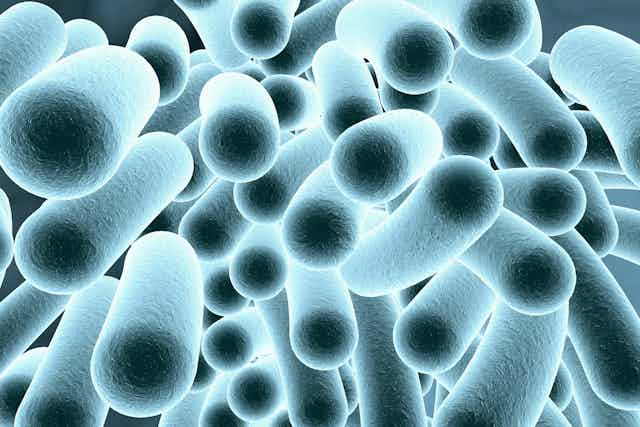Humans are crawling with microorganisms – indeed, each of us has our own unique microbial ecosystem, otherwise known as a “microbiome”. Microorganisms are the smallest forms of life, and the human microbiome includes bacteria, viruses and fungi. There are more microbial cells on and in our bodies than the ten trillion human cells which make us what we are. This microbial life helps us to break down our food, provides vitamins we cannot produce and plays a big role in keeping us healthy.
On a daily basis, we walk around surrounded by our own unique microbial cloud. Given that the skin, hair and dust we shed is covered in microorganisms, it’s hardly surprising that our built environment is also full of microbial life.
This “contamination” can pose a risk. For example, in hospitals, doctors are wary of microorganisms such as Staphylococcus aureus, which can cause infection. And most people know that bacteria such as Salmonella, which might be present on food or kitchen surfaces, can give you food poisoning.
Gone to work
But what about our offices? We spend much of our working lives in office buildings, yet we know relatively little about the microbiome of these spaces. To find out what kind of microorganisms live in our work places, scientists from the American Society for Microbiology investigated the microbiome of three different surfaces (carpet, ceiling tile and wall), in three different offices, in three cities (San Diego, Flagstaff and Toronto) over a 12-month period.
This was no easy task. Normally, if they wanted to know about which microbes were present, scientists would take samples from the site, grow the microorganisms on agar plates, then count the number of colonies and identify the species present. But many microorganisms are in fact “non-culturable” using current techniques, meaning that although they multiply happily in their natural environment, we can’t grow them in the lab.
So, instead, the researchers identified the types of microorganisms present – particularly bacteria – using molecular biology, which characterises unique parts of the organisms’ DNA. Molecular identification can indicate the presence of many more different types of microorganisms, and can detect very low numbers of cells - though it can’t tell you exactly how many cells are present.
Keeping clean
The good news is, the amount of “biomass” material collected was small – indicating that the number of microorganisms in the offices is probably low. All three surfaces were essentially dry, so any microbes that attached would likely be unable to grow because of the lack of moisture. This means that any increase in biomass over time would be due to additional microorganisms being deposited, rather than the formation of a thriving microbial community.
The researchers also found no difference in the bacterial communities on each of the surface materials. This is interesting and perhaps unexpected, because the texture of the materials would vary, the numbers of microorganisms harboured would be different, and the porosity, density and chemistry of the surfaces might affect retention of moisture and dirt.
But in order to be able to control the experiments, the scientists needed to use new test materials, which were located out of the way of most of the office activity. However, they did find a greater variety of microorganisms on the floor than on the ceiling – suggesting that areas which are used more will be at greater risk of contamination.

The origin of most of the bacteria was non-human, and it was shown that other sources in the environment – such as air, dust, animals, plants, trees – were contributing to a city-specific bacterial community. So, the cities determined the nature of the office microbiome to a greater extent than the people in the office, or the office itself. This is presumably due to their differing geography, location and extent of industrialisation. Indeed, the researchers reported that they could detect which city any given sample came from, based only on its microbial make up, to an accuracy of 85%.
The fact is, most of the bacteria that you’re likely to find in offices can survive for several weeks without much nourishment. But they can only multiply if water and nutrients such as dust, crumbs and skin scales become available, and if the temperature is hospitable. So, if you’ve eaten lunch at your desk recently, or if it’s been a while since you cleaned your keyboard or phone, the chances are that your colleagues aren’t the only life forms you’re sharing your work space with.
It’s inevitable that we’ll find germs in and around the office. And many studies are concerned about the contamination of inert surfaces by microorganisms, and their potential impacts on health. But for the most part, we can keep the office microbiome under control by ensuring surfaces are clean and dry.

